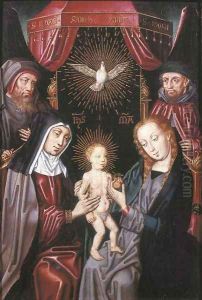School Of Ghent Paintings
The School of Ghent refers not to a single artist, but to a group of painters, sculptors, and other artists who were active in the city of Ghent, which is in present-day Belgium, during the late medieval and early Renaissance periods. This 'school' is characterized by the artistic styles and techniques that were prevalent in this region from the 15th to the 17th centuries. The term is used more broadly to categorize the cultural and artistic output of the area rather than to describe a formal institution or a cohesive group of artists with a shared doctrine.
The city of Ghent was, during this period, one of the largest and most important cities in Europe, and it became a vibrant center for the arts. One of the most famous works associated with the School of Ghent is the Ghent Altarpiece, also known as 'The Adoration of the Mystic Lamb,' completed in 1432 by the brothers Hubert and Jan van Eyck. This masterpiece is often considered one of the defining works of the Northern Renaissance and is renowned for its intricate detail and use of oil paint, a medium that the van Eyck brothers were instrumental in popularizing.
The influence of the van Eycks and their contemporaries extended beyond their lifetimes and helped to establish a tradition of fine painting in Ghent and the surrounding regions. Subsequent generations of artists in the School of Ghent continued to develop the use of oil paints, and their works were characterized by a strong attention to detail, vivid colors, and complex iconography, often with a focus on religious themes.
Although not as widely recognized as the Italian Renaissance, the Northern Renaissance, and by extension the School of Ghent, played a crucial role in shaping the course of European art history. Artists from this school contributed significantly to the development of early Netherlandish painting. However, as the Renaissance period gave way to the Baroque in the 17th century, the prominence of Ghent as an artistic center began to wane.
The term 'School of Ghent' is somewhat nebulous, as it encompasses a wide range of artists and styles over a period of two centuries. The artists from this school are less commonly known by name compared to their Italian counterparts, but their contributions to the development of Western art were substantial. Today, the works of the School of Ghent can be found in museums and collections around the world, and they continue to be studied for their historical significance and artistic merit.
